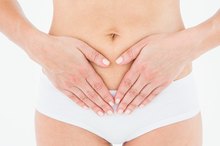What does fact checked mean?
At Healthfully, we strive to deliver objective content that is accurate and up-to-date. Our team periodically reviews articles in order to ensure content quality. The sources cited below consist of evidence from peer-reviewed journals, prominent medical organizations, academic associations, and government data.
The information contained on this site is for informational purposes only, and should not be used as a substitute for the advice of a professional health care provider. Please check with the appropriate physician regarding health questions and concerns. Although we strive to deliver accurate and up-to-date information, no guarantee to that effect is made.
Causes of Brown Spotting 10 Days After Period
A normal menstrual cycle lasts anywhere between 25 to 36 days. During this cycle, bleeding should only occur in this first week for three to seven days. However, some women may experience light brown bleeding in between periods known as spotting. There are many causes for spotting, some normal and others requiring medical attention.
Implantation Spotting
Midway through a woman’s menstrual cycle, levels of the hormones estrogen and progesterone rise causing a follicle within the ovary to release an egg. When this egg is fertilized and has reached the blastocyst stage, it will attach to the uterine lining. During this time, some women may know that they are pregnant; however, other women may feel slight abdominal pain and may bleed a little. This bleeding is called implantation bleeding and it may be pink, red or brown in color 1. Implantation bleeding is normally very light and may only require a woman to wear a pantyliner for protection 1.
- Midway through a woman’s menstrual cycle, levels of the hormones estrogen and progesterone rise causing a follicle within the ovary to release an egg.
Ovulation Spotting
Menopause & Bleeding Hemorrhoids
Learn More
Ovulation spotting occurs at the time a woman is ovulating. This bleeding normally occurs midway through a woman’s menstrual cycle. As of 2010, the causes of ovulation spotting are unknown, but according to MayoClinic.com, it may be due to the ovary surface stretching or slight bleeding from the follicle rupturing within the ovary and irritating the abdominal lining 2. Ovulation spotting lasts just a few days and the bleeding is normally very light. Also during this time, a woman may experience light cramping on one side of the abdomen, this is known as mittelschmerz or middle pain 2.
Uterine Fibroids
Uterine fibroids are benign uterine growths that form in the uterine muscle, uterine lining and the uterine cavity. Uterine fibroids can be microscopic or large enough to weigh several pounds and completely fill the uterine cavity. The causes of uterine fibroids are unknown, however it is known that they are estrogen sensitive. This means that a woman who has developed uterine fibroids will continue to have them or they will continue growing until the stage of menopause. Uterine fibroids cause:
- heavy menstrual bleeding
- bleeding between menstrual cycles
- pelvic pressure
- pelvic pain
- constipation
- backache
- leg pain
As many as 75 percent of women will develop uterine fibroids at some point in their reproductive years, the Mayo Clinic notes.
- Uterine fibroids are benign uterine growths that form in the uterine muscle, uterine lining and the uterine cavity.
- Uterine fibroids can be microscopic or large enough to weigh several pounds and completely fill the uterine cavity.
Related Articles
References
- Just Mommies: Implantation Bleeding
- MayoClinic.com: Mittelschmerz
- de la Cruz MS, Buchannan EM. Uterine fibroids: Diagnosis and treatment. Am Fam Physician. 2017 Jan 15;95(2):100-107.
- Gurusamy KS, Vaughan J, Fraser IS, Best LM, Richards T. Medical therapies for uterine fibroids - a systematic review and network meta-analysis of randomised controlled trials. PLoS ONE. 2016;11(2):e0149631. doi:10.1371/journal.pone.0149631
- Donnez J, Dolmans MM. Uterine fibroid management: from the present to the future. Hum Reprod Update. 2016;22(6):665–686. doi:10.1093/humupd/dmw023
- National Institute of Child Health and Human Development. Uterine Fibroids.
- The Merck Manuals Online Medical Library. Uterine Fibroids.
- U.S. Department of Health and Human Services. Uterine Fibroids fact sheet.
- Lippman, SA et al. Uterine Fibroids and Gynecologic Pain Symptoms in a Population-Based Study. Fertility and Sterility. 2003 Dec;80(6):1488-94
Writer Bio
April Khan is a medical journalist who began writing in 2005. She has contributed to publications such as "BBC Focus." In 2012, Khan received her Doctor of Public Health from the University of Medicine and Dentistry of New Jersey. She also holds an Associate of Arts from the Art Institute of Dallas and a Master of Science in international health from University College London.






